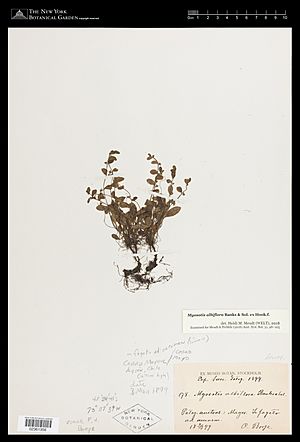Myosotis albiflora facts for kids
Quick facts for kids Myosotis albiflora |
|
|---|---|
 |
|
| Herbarium specimen of Myosotis albiflora | |
| Scientific classification | |
| Genus: |
Myosotis
|
| Species: |
albiflora
|
Myosotis albiflora is a type of flowering plant that belongs to the family called Boraginaceae. It is also known as a forget-me-not. This plant grows naturally in southern Chile and Argentina.
Scientists Joseph Banks and Daniel Solander first described this plant in 1846. Their work was published in a book called Flora Antarctica by Joseph Dalton Hooker. Myosotis albiflora plants are perennial, meaning they live for more than two years. They have pretty white flowers. It is one of only two types of native Myosotis plants found in southern South America.
About the Name
The scientific name for this plant is Myosotis albiflora. It was named by Joseph Banks and Daniel Solander in 1846. They published their findings in a book by Joseph Dalton Hooker called Flora Antarctica.
The name albiflora comes from two Latin words: albus, which means white, and floris, which means flower. So, albiflora simply means "white flower," which perfectly describes its white blooms!
The first plant specimen used to describe Myosotis albiflora was collected in Tierra del Fuego, Argentina. It is now kept at the Natural History Museum in London, England.
How It Looks
Myosotis albiflora plants usually grow as a single group of leaves called a rosette. Each plant can have 1 to 17 rosette leaves. These leaves have stalks (called petioles) that are about 6 to 30 mm long. The leaf blades themselves are 7 to 39 mm long and 3 to 12 mm wide. They are shaped like an oval or a narrow egg, widest in the middle or above. The top of the leaves is covered with tiny, straight hairs.
Each plant grows 4 to 15 flower stalks, which can be creeping, sprawling, or standing upright. These stalks are 7 to 23 cm long and may or may not have branches. There can be up to 15 flowers on each stalk. Each flower grows on a short stem and has a small leaf near it.
The part of the flower that protects the bud, called the calyx, is 2–3 mm long when the flower blooms. It grows a bit longer, up to 4 mm, when the plant produces fruit. This calyx is covered in short, soft hairs.
The flowers are white and can be up to 5 mm across. The petals are usually broad and flat. Inside the flower, the pollen-producing parts (anthers) are usually hidden. After flowering, the plant produces four small, smooth, shiny, light to medium brown seeds, called nutlets. They are about 1.8 to 2.1 mm long and 1.2 to 1.4 mm wide.
These plants typically flower and produce fruit from December to March.
Where It Grows
Myosotis albiflora is native to southern South America. You can find it in parts of Chile, specifically in the Aisén and Magallanes areas. It also grows in Argentina, especially in Tierra del Fuego.
This plant prefers wet or moist places. It is often found in coastal areas on sand or rocks. You might see it near beaches, streams, or waterfalls, usually at elevations from sea level up to 50 meters.
Conservation Status
The conservation status of a plant tells us if it is at risk of disappearing. Myosotis albiflora is not currently listed on the IUCN Red List. This list tracks plants and animals that are endangered or threatened.
There isn't much information available about how many Myosotis albiflora plants exist. Scientists have not collected many samples, and there isn't much data on the size of its populations. Some old plant labels say it was "escasa" (rare) or "esparcidamente" (sparse) where it was found. This suggests it might not be very common.
See also
 In Spanish: Myosotis albiflora para niños
In Spanish: Myosotis albiflora para niños

